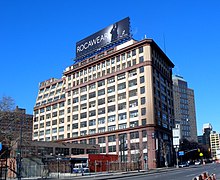Sperry Corporation
| Sperry Corporation | |
|---|---|
| legal form | Corporation |
| founding | 1910 |
| resolution | 1986 |
| Reason for dissolution | fusion |
| Seat |
Lake Success , New York , United States |
The Sperry Corporation (1910–1986) was a large American company that manufactured, among other things, electronics , computers , agricultural machinery and hydraulic equipment. In 1986, Sperry merged with Burroughs Corporation. The business areas of both companies were combined under the name Unisys .
Company history
Beginnings
The company was founded in 1910 as the Sperry Gyroscope Company by Elmer Ambrose Sperry for the manufacture of nautical navigation devices such as gyroscopes or gyroscopes . For his Gyro ( English gyrocompass ) Sperry had received a US patent in 1908. When trying to sell gyrocompass systems to the German Imperial Navy , there was a patent dispute with Hermann Anschütz-Kaempfe in 1914 , in which Albert Einstein was called in as an expert. Einstein ultimately spoke out against Sperry.
- In 1918, Lawrence Sperry separated from his father Elmer Ambrose and founded the Lawrence Sperry Aircraft Company , a flight navigation components company that also manufactured and sold its new autopilot system.
- 1924 After the death of Lawrence Sperry on December 13, 1923, the father and son companies were merged again.
- In 1933 the company was called Sperry Corporation , it was now a holding company to which many companies belonged, e.g. B. the original
- Sperry Gyroscope ,
- Ford Instrument Company
- Intercontinental Aviation and others.

The company grew during World War II as a result of the war economy; it specialized in high technology such as target devices for bombs , airborne radar systems and automatic take-off and landing systems. These included the ball- shaped turret known as the " Ball Turret ", which was used in the Boeing B-17 Flying Fortress and the Consolidated B-24 Liberator. After the war, interest shifted to electronics and computer systems .
- In 1937, through a share swap, Vickers Inc. became part of the holding company, Harry Vickers became Vice President.
- In 1947 the agricultural and construction machinery manufacturer New Holland was bought.
- In 1953 the first digital computer ( SPEEDAC ) was built.
Sperry Rand
In 1955, Sperry acquired the Remington Rand company and was called Sperry Rand from then on . Remington since 1950 belonged to one of the ENIAC developers J. Presper Eckert and John Mauchly built computer department, according to their assigned Remington, the UNIVAC I developed. It was strengthened by the acquisition of Engineering Research Associates (ERA) with the know-how for drum storage , a forerunner of hard disk storage . On this basis, Sperry Rand further developed the UNIVAC computer series.
Sperry Rand's Univac belonged to the group of manufacturers that competed with IBM with mainframes under the acronym BUNCH (for Burroughs , Univac, NCR , CDC , Honeywell ) in the 1960s and 1970s . Univac computers were particularly successful with aviation companies that operated their booking systems on them.
In 1978 Sperry Rand decided to focus on the computer business and sold Remington Rand Systems, Remington Rand Machines, Ford Instrument Company, Sperry Aerospace, and Sperry Vickers. The word "edge" has been deleted from the name; henceforth the company was again called Sperry Corporation. The UNIVAC division was henceforth called Sperry Univac and some time later simply Sperry .
In 1984 Sperry sold the Sperry Vickers hydraulic division to Libbey-Owens-Ford .
Products (selection)
Takeover by Burroughs
In 1986, Sperry merged with Burroughs Corporation . The divisions of both companies were combined under the name Unisys ; the traditional names Sperry and Burroughs were given up. Sperry's other businesses, such as Sperry New Holland , Sperry Gyroscope, Sperry Vickers, Sperry Marine, and Sperry Flight Systems, were sold after the merger.
literature
- A History Of Sperry Rand Corporation , 1967
- A Brief History of Sperry Corporation , undated
- David E. Lindstrom: A few good men from Univac. Cambridge, MA and London, MIT Press, 1987. ISBN 0-262-12120-4 ( Online , PDF)
